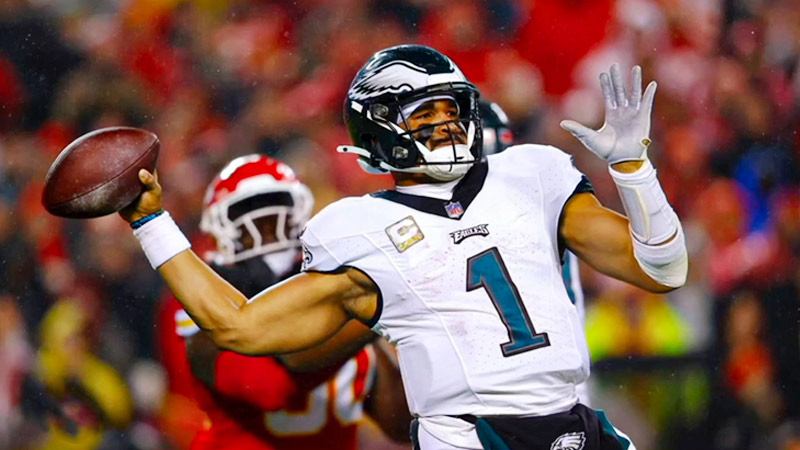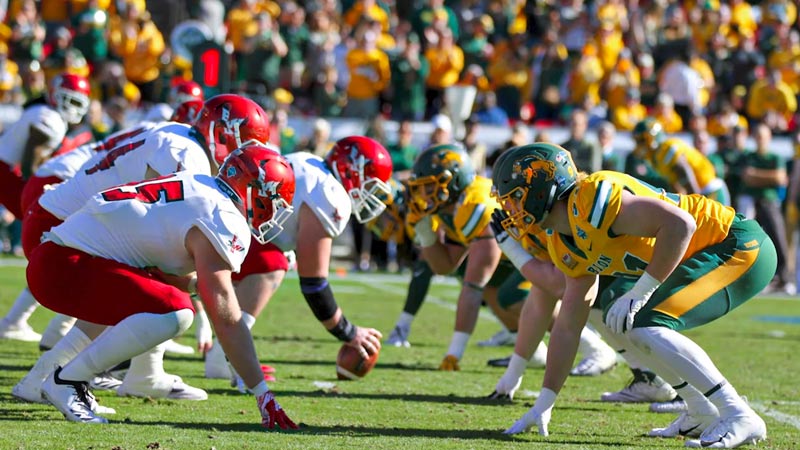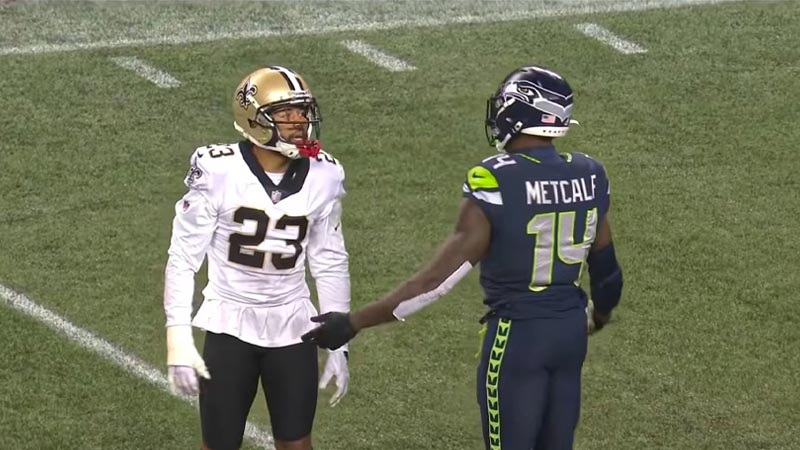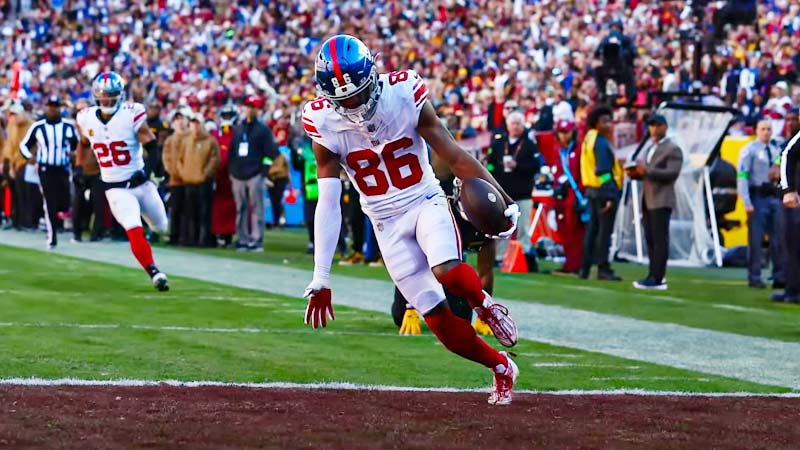American football is a thrilling and dynamic sport that captivates millions of fans worldwide. However, understanding its complex rules and terminologies can be intimidating for newcomers.
This blog post on American Football Basics aims to demystify the sport and provide a comprehensive introduction. We’ll cover the fundamentals, including the field, positions, gameplay, scoring, penalties, and common terminologies.
Whether you’re a curious newcomer or just looking to enhance your understanding, this guide will break down the game’s key elements in a clear and accessible manner.
From touchdowns to tackles and offensive plays to defensive strategies, this primer will equip you with the knowledge needed to appreciate the excitement and strategy of American football. Stay sharp till the end.
American Football Basics on The Field and Positions
American football is a dynamic team sport played on a rectangular field, with the primary objective of advancing an oval-shaped ball, known as a football, into the opposing team’s end zone to score points.
The field is divided into four quarters, each lasting 15 minutes, and features a 100-yard playing surface, with end zones at each end. Two teams, each comprising 11 players, compete against one another.
The offensive team aims to move the ball down the field through a combination of running and passing plays, while the defensive team endeavors to stop their progress.
Key player positions include the quarterback, responsible for passing the ball; running backs, who carry it; wide receivers and tight ends, who catch passes; and linemen, who protect the quarterback and create openings for runners.
Defensively, positions like linebackers, cornerbacks, and safeties work to thwart the offense.
American football combines strategic play-calling, physicality, and teamwork, making it a captivating and popular sport in the United States and beyond.
The Basics of Gameplay in Football
Here, we have mentioned some of the basics of gameplay in American football. Check them out below.
The Kickoff
The game begins with a kickoff, where one team kicks the ball to the other to start the match. The receiving team tries to advance the ball as far as possible down the field.
Passing and Running

The offense can move the ball by running (carrying the ball) or passing (throwing it) to their teammates.
The quarterback is the key player in passing, while running backs are typically responsible for carrying the ball.
Downs
Each team has four downs (chances) to advance the ball 10 yards. If they succeed, they get another set of four downs. If not, possession is turned over to the opposing team.
Yardage Markers
The field is marked with lines every 10 yards, allowing players and fans to track progress.
The line of scrimmage is where each play starts, and teams must reach or exceed the next set of 10 yards to gain a new set of downs.
Scoring
Teams can score in various ways. A touchdown is worth six points and is achieved by carrying the ball into the opponent’s end zone. After a touchdown, they can attempt a one- or two-point conversion.
Field goals, made by kicking the ball through the opponent’s goalposts, are worth three points. Safeties, which occur when the defense tackles the offense in their own end zone, are worth two points.
The Play Clock
Teams have a limited amount of time (usually 40 seconds) to start a play after the previous one ends. If they don’t, they’ll incur a penalty.
Defensive Strategies
The defense aims to prevent the offense from gaining yardage or scoring.
They can use various strategies, including blitzes (aggressive pass rushes), coverage schemes (marking receivers), and tackling the ball carrier.
Turnovers
A significant part of the game involves turnovers, where one team gains possession from the other.
Interceptions (catching a pass intended for the other team) and fumbles (losing control of the ball) are common ways to change possession.
These are the fundamental elements of American football gameplay.
The game’s complexity and strategy, along with the physicality of the sport, make it a captivating and dynamic contest loved by millions worldwide.
Key Game Concepts of American Football
Some key game concepts in American football are mentioned in the following section.
Line of Scrimmage

This imaginary line extends across the width of the field where each play begins. The offense lines up on one side, and the defense lines up on the other.
The ball is placed at the line of scrimmage, and the play starts when it’s snapped to the quarterback. The line of scrimmage is crucial in determining each play’s course.
Downs
American football is divided into plays or downs. Each team has four downs to advance the ball 10 yards.
If they succeed, they get a new set of downs. If not, possession goes to the opposing team. Teams use different offensive plays on each down, depending on how far they need to advance.
Offensive Formation
The way offensive players line up before the snap is called an offensive formation.
Different formations allow for various strategies and plays, including positions like wide receivers, running backs, tight ends, and offensive linemen.
The choice of formation can give clues to the opposing defense about the intended play.
Zone and Man-to-Man Defense
Defenses can be organized into zone coverage, where defenders cover specific areas of the field, or man-to-man coverage, where each defender is responsible for a specific offensive player.
The choice of defense depends on the game situation and the opponent’s strengths.
Audibles
Audibles are changes made at the line of scrimmage by the quarterback to adjust the play based on the defense’s alignment.
This involves calling out new plays or adjusting the original play call. It’s a way to exploit the defense’s weaknesses or protect against an anticipated threat.
Blitz
A blitz is a defensive strategy in which extra defenders, often linebackers or defensive backs, rush the quarterback to put pressure on them.
This tactic can disrupt the passing game and leave potential gaps in pass coverage, making it a high-risk, high-reward strategy.
Clock Management
Managing the game clock is critical in American football.
Teams must be aware of the game clock and the play clock, which dictate how much time is left in the game and how much time they have to snap the ball before incurring penalties.
Effective clock management can determine the outcome of a game.
Special Teams
Special teams plays, such as kickoffs, punts, and field goal attempts, are essential in field position and scoring.
Kick returners and punt returners try to gain as many yards as possible on returns, while field goal kickers aim to score three points by accurately kicking the ball through the uprights.
These key concepts are essential for both players and fans of American football, as they form the basis of the game’s strategy, tactics, and excitement.
Time Management and Overtime in American Football

Time management and overtime in American football are critical aspects of the game that ensure fair play and determine the outcome when regulation play ends. Here’s an overview of these aspects:
Regulation Play
Here are some core aspects of regulation play in American football.
Four Quarters
An American football game is typically divided into four quarters, each lasting 15 minutes. The clock runs continuously, stopping only for certain events like incomplete passes, out-of-bounds plays, and timeouts.
Play Clock
Each offensive play has a play clock, typically 40 seconds. Teams must snap the ball before the play clock expires, or they’ll be penalized. This encourages a steady pace of play.
Two-Minute Warning
The NFL has a two-minute warning at the end of the first and second halves, during which the clock stops. Teams often use this time strategically to plan plays and manage the clock effectively.
Timeouts
Teams have limited timeouts during each half (usually three). They can call timeouts to stop the clock, regroup, or discuss strategy. Efficient use of timeouts is crucial in late-game situations.
Overtime
Here are some important aspects of the overtime in the American football.
Overtime Period
An overtime period is played if the game is tied at the end of the fourth quarter. The NFL and college football have different rules for overtime.
NFL Overtime
In the NFL, each team can possess the ball, starting at the opponent’s 25-yard line. The game continues until there’s a winner. If the first possession results in a touchdown, the game ends.
The opposing team can match or win if a field goal is scored. If neither team scores on their first possession, the game becomes sudden death.
College Football Overtime
In college football, each team alternates possessions starting at the opponent’s 25-yard line. The game goes to a second overtime period if it’s still tied.
From the third overtime onward, teams run a “two-point conversion shootout,” where they attempt a two-point conversion after scoring a touchdown instead of starting from the 25-yard line.
Tiebreaker
If the game remains tied after the overtime period(s), it’s declared a tie in college football.
In the NFL, regular-season games can end in a tie, but playoff games have additional overtime periods until a winner is determined.
Effective time management, especially in late-game situations, is crucial for teams looking to maximize their scoring opportunities or run out the clock to secure a win.
Penalties in American Football

Penalties in American football violate the rules and regulations governing the game.
These infractions result in consequences for the offending team. Here are some key aspects of penalties in American football:
Types of Penalties
Penalties are categorized into two main types: offensive and defensive.
Offensive penalties occur when the offense violates the rules, while defensive penalties involve infractions the defense commits. Examples include holding, pass interference, and false starts.
Personal Fouls
These penalties involve unnecessary roughness or unsportsmanlike conduct, often resulting in significant yardage penalties.
Personal fouls can lead to ejections if they are particularly severe, such as targeting (intentional helmet-to-helmet hits).
Yardage and Down Consequences
Most penalties result in a loss or gain of yardage and may affect the number of downs a team has to work with.
For instance, a holding penalty on the offense typically results in a 10-yard loss, and the down is replayed.
A pass interference penalty on the defense usually results in an automatic first down for the offense.
Automatic First Down
Some penalties, known as “automatic first downs,” award the offensive team a first down.
For instance, defensive pass interference gives the offense an automatic first down, regardless of how many yards are needed for a first down.
Offensive Holding
This penalty occurs when an offensive player impedes the progress of a defender by grabbing onto their uniform or body. It results in a 10-yard loss and a replay of the down.
False Start
False start penalties occur when an offensive player (usually a lineman) moves before the snap.
It leads to a 5-yard loss and a replay of the down. False starts disrupt the timing of plays and can put the offense at a disadvantage.
Pass Interference
Pass interference is a significant defensive penalty. It happens when a defender interferes with a receiver’s opportunity to catch a pass.
This results in an automatic first down for the offense and yards gained depending on the severity of the infraction.
Delay of Game
The delay of the game penalty is called when a team fails to snap the ball before the play clock expires.
It results in a 5-yard loss of yardage and a replay of the down. Teams must manage the play clock efficiently to avoid this penalty.
Penalties play a crucial role in maintaining the integrity of the game, ensuring fair play, and penalizing teams for rule violations.
Understanding the implications of penalties is essential for players, coaches, and fans, as they can significantly impact the outcome of a game.
American Football Terminologies
American football has many unique terminologies and jargon that can confuse newcomers. Here’s a list of some key American football terminologies:
- Touchdown (TD): When a player carries or catches the ball in the opponent’s end zone, it’s worth six points.
- Field Goal (FG): Kicking the ball through the opponent’s goalposts is worth three points.
- Extra Point (PAT): Teams can attempt a one-point or two-point conversion after a touchdown. The one-point attempt is often called a “PAT” or “point after touchdown.”
- Safety: It’s worth two points when the defense tackles an offensive player in their own end zone.
- Down: Each offensive play is called a “down.” Teams have four downs to advance the ball 10 yards for a new set of downs.
- Line of Scrimmage: An imaginary line where each play begins, separating the offense from the defense.
- Sack: When a defensive player tackles the quarterback behind the line of scrimmage before they can pass or hand off the ball.
- Interception (INT): When a defensive player catches a pass intended for an offensive player.
- Fumble: When a player loses control of the ball, and it’s loose on the field.
- Red Zone: The area between the opponent’s 20-yard line and the end zone, where scoring opportunities are higher.
- Two-Minute Warning: In the NFL, a warning at the end of each half that stops the clock and allows teams to strategize.
- Hail Mary: A deep, desperate pass attempt, often as time expires, with a low chance of success.
- Blitz: A defensive strategy where extra defenders rush the quarterback in an attempt to pressure or sack them.
- Shotgun Formation: The quarterback lines up a few yards behind the center instead of under center before the snap.
- Quarterback (QB): The key offensive player who throws passes and orchestrates the offense.
- Running Back (RB): The primary ball carrier in the offense, often used for rushing plays.
- Wide Receiver (WR): Players who catch passes from the quarterback.
- Tight End (TE): A player who can both block and catch passes, often lining up on the offensive line.
- Offensive Line (OL): The group of players responsible for protecting the quarterback and creating running lanes for the running back.
- Defensive Line (DL): The front-line defenders press the quarterback and stop the run.
- Linebacker (LB): Versatile defenders who can tackle, cover receivers, and rush the quarterback.
- Cornerback (CB): Defensive players responsible for covering wide receivers.
- Safety (S): The last line of defense in the secondary, responsible for covering deep passes and providing run support.
- End Zone: The 10-yard-deep area at each end of the field, where touchdowns are scored.
- Audible: A last-minute change to the play called by the quarterback based on the defensive alignment.
FAQs
What are the key positions in American football?
In American football, key positions include the quarterback, running back, wide receiver, tight end, offensive linemen, defensive linemen, linebackers, cornerbacks, and safeties.
Each position has specific roles and responsibilities in both offense and defense.
How is scoring done in American football?
Scoring in American football is achieved through touchdowns (6 points), field goals (3 points), and extra points (1 or 2 points after a touchdown).
Safety (2 points) is another scoring option when the defense tackles an offensive player in their own end zone.
What is the purpose of downs in American football?
Downs in American football are a series of four opportunities for the offense to advance the ball 10 yards down the field.
Each successful 10-yard gain results in a new set of downs, allowing the offense to continue their drive.
How does overtime work in American football?
In overtime, both teams can possess the ball starting from the opponent’s 25-yard line (NFL) or through alternating possessions (college football).
Overtime play continues until a winner is determined, with each team having an equal opportunity to score.
What is the role of the offensive line in American football?
The offensive line, consisting of offensive tackles, guards, and a center, protects the quarterback, creates running lanes for the running back, and blocks the defense.
They form a crucial barrier between the defense and the quarterback, enabling offensive plays to develop.
Wrapping Up
American football is a multifaceted and exhilarating sport, enriched by its intricate rules and strategies.
This beginner’s guide has illuminated the fundamental aspects of the game, from field dimensions and player positions to scoring, penalties, and unique terminologies.
Whether you’re watching your first game or eager to deepen your appreciation, the knowledge you’ve gained here will serve as a solid foundation.
As you delve deeper into the world of American football, you’ll find endless nuances and a remarkable blend of athleticism and tactics. So, grab your jersey, join the huddle, and cheer on your favorite team with newfound confidence.
The journey to understanding American football begins here, and the excitement that unfolds on the gridiron is bound to keep you enthralled for seasons to come. Best wishes.







